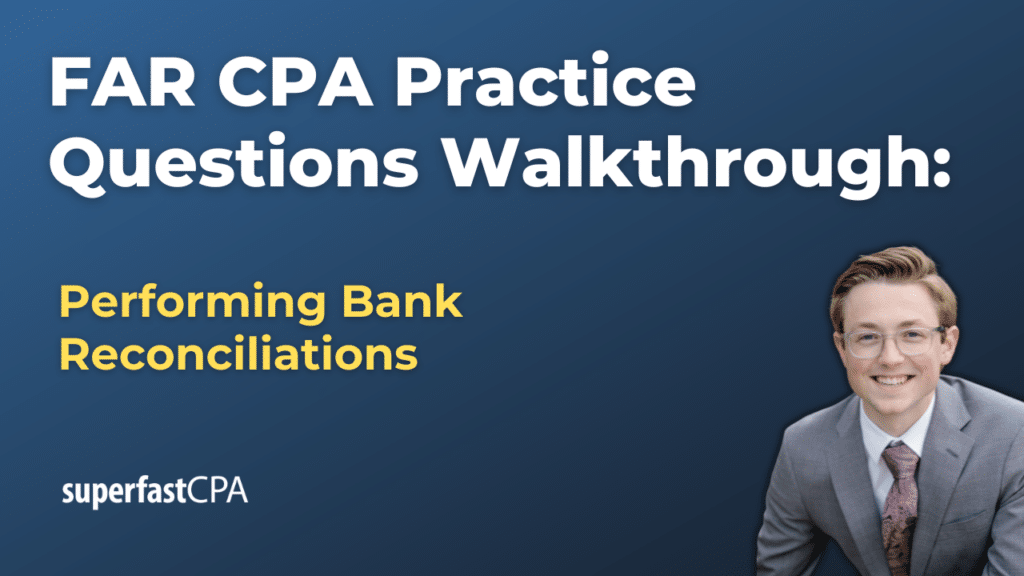In this video, we walk through 5 FAR practice questions teaching about performing bank reconciliations. These questions are from FAR content area 2 on the AICPA CPA exam blueprints: Select Balance Sheet Accounts.
The best way to use this video is to pause each time we get to a new question in the video, and then make your own attempt at the question before watching us go through it.
Also be sure to watch one of our free webinars on the 6 “key ingredients” to an extremely effective & efficient CPA study process here…
Performing Bank Reconciliations
Performing bank reconciliations is a crucial process for ensuring the accuracy of a company’s cash records. It involves comparing the cash balances between the company’s general ledger and the bank statement to identify and adjust for any discrepancies. This guide walks you through the process step-by-step, highlighting the most common scenarios and adjustments needed to get the correct ending cash balance for both.
Step 1: Compare the General Ledger and the Bank Statement
Start by examining both the general ledger and the bank statement. Identify deposits and checks recorded in both, and highlight any differences or missing entries. For example:
- General Ledger Entry:
9/05: Deposit – $4,500
9/10: Check 203 – $1,200 - Bank Statement Entry:
9/05: Deposit – $4,500
9/15: Check 204 – $1,800
In this example, both entries have the 9/05 deposit, but the checks do not match. Check 204 is in the bank statement but not in the general ledger, meaning it may have been missed in the company’s books.
Adjustment Needed: Subtract the amount of Check 204 from the general ledger to reflect that it has been cleared by the bank, and the bank will have to include Check 203.
Step 2: Adjust for Voided Checks
A voided check is one that the company has marked as canceled before it was cashed by the payee. Voided checks often occur due to errors in the check details or changes in the amount owed. If the voided check was already recorded in the general ledger, it needs to be reversed (added back).
Example Scenario:
- Original Entry:
9/08: Check 206 – $1,000 (recorded in the general ledger) - Voided on 9/10: – the check was voided before it was deposited by the payee.
Adjustment Needed:
Add $1,000 back to the general ledger because the cash was never withdrawn.
Step 3: Adjust for Returned Checks (NSF)
Non-Sufficient Funds (NSF) checks occur when a customer’s payment is rejected due to a lack of funds in their account. The company must treat this check as if it never received the payment and update its general ledger to reflect that the money was not collected.
Example Scenario:
- Initial Entry in General Ledger:
9/05: Customer Payment – $2,500 (Debit Cash, Credit Accounts Receivable) - NSF Occurred:
9/12 — the bank returned the check due to NSF, and the company has not yet adjusted for this.
Adjustment Needed:
Subtract $2,500 from the general ledger to reverse the payment entry, as the company did not actually receive the funds.
Step 4: Account for Bank Fees and Service Charges
Banks often charge service fees, NSF fees, or other transaction-related charges that may not be recorded in the company’s general ledger. When reconciling, these fees must be deducted from the cash balance in the general ledger to reflect the accurate cash position. Typically the bank will have already taken these fees into account.
Example Scenario:
- Bank Statement Shows:
9/15: Service Fee – $35
9/22: NSF Fee – $25 - General Ledger Does Not Show These Entries.
Adjustment Needed:
Subtract $35 and $25 from the general ledger cash balance.
Step 5: Adjust for Deposits in Transit and Outstanding Checks
Deposits in transit and outstanding checks are timing differences that appear in the bank statement and general ledger at different times. A deposit in transit is a deposit recorded in the books but not yet reflected in the bank statement, while an outstanding check is a check written by the company that has not yet cleared the bank.
Example Scenario:
- General Ledger Deposit Entry:
9/28: Deposit – $6,500 (not yet in the bank statement)
Adjustment Needed for Bank Statement:
Add $6,500 to the bank statement to reflect that the deposit will eventually clear.
- Outstanding Check in General Ledger:
9/25: Check 210 – $3,200 (has not cleared the bank)
Adjustment Needed for Bank Statement:
Subtract $3,200 from the bank statement to account for the pending withdrawal.
Step 6: Reconcile and Arrive at the Correct Ending Balance
After making all adjustments, the ending cash balance in both the general ledger and the bank statement should match. If not, recheck the entries for missing or misclassified transactions.
Example of Complete Reconciliation:
- Initial Ending Balances:
General Ledger: $8,000
Bank Statement: $10,000 - Adjustments for the General Ledger:
- Add back voided Check 206: +$1,000
- Subtract NSF Check: -$2,500
- Subtract NSF Fee: -$25
- Add missing deposit: +$3,000
- Adjustments for the Bank Statement:
- Subtract outstanding Check 210: -$3,200
- Add missing deposit: +$2,675
Final Balance:
After adjustments, both the general ledger and the bank statement have an ending cash balance of $9,475, meaning the reconciliation is complete and accurate.
Key Takeaways:
- Compare the general ledger and bank statement line-by-line.
- Account for voided checks and returned checks (NSF).
- Include bank fees and service charges that haven’t been recorded.
- Adjust for timing differences like deposits in transit and outstanding checks.
- Ensure the ending balance matches in both records.













